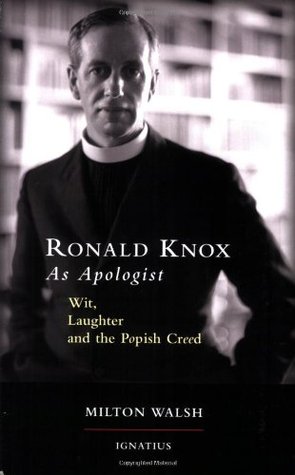In the Catholic Church, apologetics—explaining the Faith—was on its way to becoming a lost art during the post-Vatican II era. But thanks to Mother Angelica’s efforts on EWTN and the many classic publications emanating from Ignatius Press, this important form of evangelization has not been completely lost. However, the uproar caused last summer by the Congregation for the Doctrine of the Faith’s “Responses to Some Questions Regarding Certain Aspects of the Doctrine of the Faith” (July 10), which reaffirmed that the one, true Church “subsists” in the Catholic Church, reminds us how important apologetics is for extra- and intra-ecclesial instruction and understanding.
From the beginning of Christianity, apologists such as Justin Martyr and Origen have preached and written on Catholic beliefs to clarify the Faith for the faithful, to answer the attacks of Church opponents, and to attract converts. Before the Second Vatican Council (1962-65), Archbishop Fulton J. Sheen was the premiere apologist in America. Another important figure in apologetics (and a contemporary of Sheen) was the Englishman Msgr. Ronald Knox. In Ignatius Press’s newly released Ronald Knox as Apologist: Wit, Laughter and the Popish Creed, Milton Walsh reintroduces us to this scholarly convert who became a priest and dedicated his life to teaching the truths of the Faith.
Like the great John Henry Cardinal Newman, Ronald Knox (1888-1957) was led in his thirst for truth from Anglicanism to Rome. The centrality of truth in Knox’s work is best summed up in the following quip:
“What is truth?” Pilate asked, and it serves him right that he should be put there in the middle of the Credo, as if the Church were determined to go on saying to him to the end of time, “Here, you fool, this is it!”
For Knox, the truths proclaimed by the Church are guaranteed by Her apostolicity. In a polemical letter to his father, who was a minister of the evangelical wing of the Church of England, Knox compared
the Church of Rome to a shop window in which there was no need to examine the goods, because over the door there was a sign “This Is The Depot Ordained By Christ Himself.”
The book is more of a primer than a biography, offering us a sampling of Knox’s writings and whetting the reader’s appetite to study both Knox and apologetics in general. The brief sketch of Knox’s career provided in the early chapters helps us to appreciate his development as an apologist. Originally, Knox was more comfortable in the intellectual stratosphere of the academy. He was also more oriented to the historical past, which is evidenced in a series of talks he gave at weekly men’s conferences while at Oxford (1926-39). These talks formed the basis for a series of books, The Belief of Catholics, which synthesized the Faith for general consumption.
However, a fortuitous request by Lady Daphne Acton for instruction in the Faith in 1939, along with an unexpected chaplaincy to high-school-aged girls who were seeking refuge at the Acton home during World War II, brought a new sensitivity to Knox’s work. It also helped him to recognize his stake in the present and the future, and moved him to apply his apologetic insights to current events. Evelyn Waugh, a friend and fellow Catholic apologist, observed this emphasis in Knox’s book God and the Atom (1945). “It was a moral and philosophical tract offered to a public obsessed by practical politics,” Waugh wrote, noting that Knox “felt himself charged with an urgent message of consolation to people who did not know that they had been hurt.”
Knox’s poignant comparison of Protestant and Catholic apologetics provides a valuable insight into the focus of his later efforts. “I would say that the Protestant approach to apologetics gives the ordinary Englishman an impression of reality without truth,” he wrote, “while the Catholic approach to apologetics gives him the impression of truth without reality.” This formulation is mindful of the deterioration that Mainline Protestantism had undergone because of the unchecked acceptance of modern biblical criticism and its logical outgrowth, the Social Gospel, which lent itself to a secular religious understanding. One can also detect in it the resonance of Knox’s critical analysis of Catholic apologetics among the fathers of Vatican II, particularly in Gaudium et Spes, The Pastoral Constitution on the Church in the Modern World, which encouraged Catholics to participate in shaping society with the truths of the Gospel.
In presenting Knox’s apologetics, Walsh provides an important resource for the new evangelization called for by Pope John Paul II—one that underscores the call of Pope Benedict XVI for a renewed effort to demonstrate the correlation between faith and reason. Passages from Knox’s work and Walsh’s commentary are invaluable for those seeking a deeper appreciation of Catholic beliefs and the interconnectedness of reason and revelation (as well as of will, grace, and faith). Knox insisted that “faith does not alter logical certitude,” and that “The two principles of reason and revelation are interlocked.”
However, he did warn that there are some truths too deep for the human mind to understand. His rich exposition of the credal truths (the Trinity, the Incarnation, Four Marks of the Church, the Sacraments) will move the reader to delve more deeply into Knox’s work. Of the Incarnation, Knox writes:
He was God already when he hung upon the cross. He was man still, when he ascended into heaven. The flying arches had been thrown out from both sides, and had met in the middle. Habemus Pontificem (We have a bridge).
Walsh’s work will be a welcome aid to those interested in combating current religious relativism and indifferentism. It will also be helpful to anyone who wishes to understand Catholicism more deeply or to engage in ecumenical dialogue regarding the uniqueness of Christ as Savior, the oneness of the Catholic Church, and the integral role of the papacy.
[Ronald Knox as Apologist: Wit, Laughter and the Popish Creed, by Milton Walsh (San Francisco: Ignatius Press) 248 pp., $14.95]

Leave a Reply